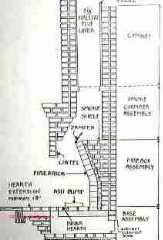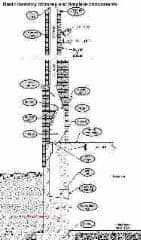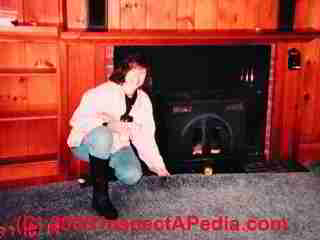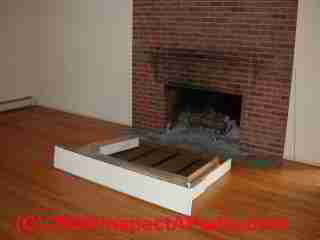 Fireplace & Hearth Damage, Cracks, Settlement or Collapse
Fireplace & Hearth Damage, Cracks, Settlement or Collapse
Inspection & Repair of Damaged Fireplaces & Hearths
- POST a QUESTION or COMMENT about inspecting, diagnosing, & repairing fireplace damage from settlement, cracks, masonry movement
Fireplaces & hearth damage, cracks, settlement, & other fire hazards:
This article describes masonry fireplace damage, cracks, settlement, and fire hazards and suggests inspection points and some repair procedures. We also link to other fireplace and chimney-fire safety articles and advice. At page top: our photo shows the collapse into the room of a poorly-secured wood frame around a masonry fireplace.
This article series provides information about masonry fireplaces, including inspection for damage/hazards (cracks and gaps that appear at masonry fireplaces due to chimney or fireplace settlement or movement), fireplace chimney sizing requirements, draft problems, chimney safety, creosote problems, inserts, and other topics.
InspectAPedia tolerates no conflicts of interest. We have no relationship with advertisers, products, or services discussed at this website.
- Daniel Friedman, Publisher/Editor/Author - See WHO ARE WE?
Masonry Fireplace Specifications, Safety Hazards, Recommendations
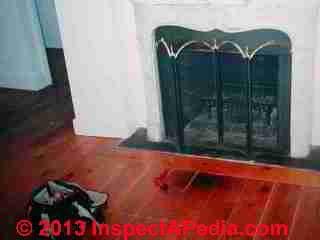 The burned wood floor in front of the fireplace shown here is a sweet example of why building codes and fire experts require a masonry hearth of adequate dimensions at the front of a fireplace.
The burned wood floor in front of the fireplace shown here is a sweet example of why building codes and fire experts require a masonry hearth of adequate dimensions at the front of a fireplace.
Watch out: while this article discusses fireplace dangers & fire risks related to cracks or settlement in the fireplace chimney, the most common fire hazard associated with fireplaces is a chimney fire caused by the ignition of accumulated creosote in the fireplace chimney flue.
[Click to enlarge any image]
See CHIMNEY FIRE ACTION / PREVENTION
Fireplace Damage and Unsafe Hearths due to Chimney or Fireplace Settlement
Why are gaps at fireplace fireboxes, hearths, or other components a dangerous fire hazard? What should you do about them?
Do not use a fireplace that is in any doubt about safety before it has been inspected by a professional. Our photo (above) shows a fireplace mantel that collapsed and fell into the room. Smoke stains revealed on the brick might point to a chimney draft problem too.
The fireplace schematic (above) shows the basic components of a masonry fireplace and their names. This drawing is obsolete in that it is missing a combustion air supply for the fireplace.
These articles on chimneys and chimney safety provide detailed suggestions describing how to perform a thorough visual inspection of chimneys for safety and other defects. Chimney inspection methods and chimney repair methods are also discussed.
Carson Dunlop Associate's sketch given below shows a cross section of the basic components of a chimney where a fireplace is installed. Carson Dunlop Associates is a Toronto home inspection & education firm.
[Click to enlarge any image]
Beginning with the outside inspection of the chimneys and structure, and continuing indoors, we check for a wide range of possible chimney hazards. Among these are issues surrounding chimney movement, settlement, or separation from the building.
Too often we discover that a building owner was aware that a chimney has moved, s/he has patched the gap between the chimney and the building, but s/he has not realized that the movement causes cracks and gaps inside the chimney or fireplace which are very dangerous.
Below we provide three photographs showing how a fireplace can become a fire hazard due to chimney settlement or inadequate support of the fireplace itself.
We start with a look at the fireplace hearth for evidence of movement.
Caulk is Not a Safe Repair for Hearth Settlement
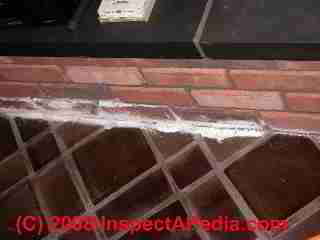
In an easy-to-spot case of movement and separation between a fireplace hearth and the building floor take a look at the white caulk installed in an open crack between the hearth face and the floor in our photo (left).
A bit more investigating was needed to determine whether the floor was sagging away from a stable masonry fireplace and chimney or whether the chimney and entire firebox were leaning away from the building.
Cracks Can Show Settlement of The Fireplace Fire-Box and Chimney OR Hearth Settlement
In the next case, just below, the gaps and cracks made it obvious that the chimney and fireplace were tipping away from the building in a dangerous condition.
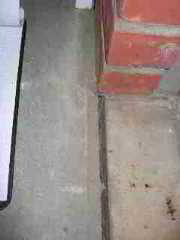 ...
... 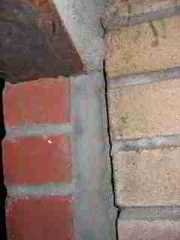
First at above left we see a gap that has opened up between the fireplace floor and the hearth (above-left). Sparks may fall into this space, causing a building fire.
Second (above right) our photo shows a crack between the face of the fireplace and the fireplace box itself. We don't know without more analysis whether the brick facing has fallen away from a sound and safe fireplace or whether the fireplace has moved away from the facing.
Cracks & Gaps Mean an Unsafe Fireplace
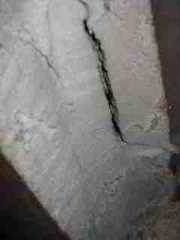
Our third fireplace damage photograph (above) is the final nail in the coffin of this unfortunate fireplace.
A gap has opened in the fireplace below the chimney where the damper was cemented in place. There has been substantial movement of the fireplace itself (and probably the chimney too) - this is an unsafe fireplace that should not be used.
But not using the fireplace is not enough to be sure this home doesn't have another fire or glue gas hazard.
If a fireplace and chimney have settled and thus have become unsafe, we need to determine right away if any other building appliances such as a boiler, furnace, water heater, or woodstove are using other flues in the same chimney.
If the chimney has multiple users it is unsafe for all of them.
Watch out: At PYROLYSIS EXPLAINED we document a Phil Hansey fireplace design that set the author's house afire on New Years' Eve in 1969. Gaps in the fireplace exposed wood to heat from the fire, eventually setting the house wall on fire. Dan Martin passed me a fire extinguisher as he asked "Is your wall supposed to glow like that?"
at FIREPLACE HEARTH DIMENSIONS & SUPPORT we illustrate adding support below a sagging fireplace hearth.
Watch out: in addition to cracks and gaps that mean heat and sparks can set a building on fire, cracks and gaps in masonry chimneys and fireplaces could presage a dangerous chimney collapse.
See these articles on chimney collapse hazards:
- CHIMNEY COLLAPSE RISKS, REPAIRS
- BRICK CHIMNEY CRACKS & COLLAPSE - case of an imminent catastrophic chimney collapse
Fireplace Fire Hazards: Carpeting too Close to Fireplace
Carpets and other combustibles need to be kept away from the fireplace front and hearth.
Often where the hearth sits at floor level we find that someone has installed carpeting right up to the fireplace - a fire hazard as our client is remarking in our photo (above).More unsafe hearths and inadequate clearance from fireplaces or wood or coal stoves are shown
at FIRE CLEARANCES, WOOD COAL & PELLET STOVES.
...
Reader Comments, Questions & Answers About The Article Above
Below you will find questions and answers previously posted on this page at its page bottom reader comment box.
Reader Q&A - also see RECOMMENDED ARTICLES & FAQs
On 2021-04-11 by (mod) - repair priorities for a damaged masonry fireplace
 @Catherine Sherlock, I'll be glad to try to help, but need to know what you want or what question you have.
@Catherine Sherlock, I'll be glad to try to help, but need to know what you want or what question you have.
Watch out: From clicking to enlarge your photo I see many burns on a wood or parquet floor that looks in poor condition; there could be a fire hazard; certainly you should not use the fireplace before both fireplace and the entire chimney and flue are inspected for safety. A professional, certified chimney sweep ought to be able to give you that information.
On 2021-04-11 by Catherine Sherlock
My fireplace is damaged
On 2020-11-22 by (mod) - first priorities for fireplace safety
D
Watch out: before attempting any repair to the fireplace hearth
1. stop using the fireplace immediately and don't use it until it's inspected and repaired
2. have the chimney and flues inspected for safety, especially if the same chimney carries other flues such as for your home heating boiler, furnace, water heater - as movement in a hearth can stress, crack, damage other chimney components making the chimney unsafe, risking fire or carbon monoxide poisoning
3. be sure you have working CO and smoke detectors now.
It might be necessary to remove flooring and install masonry supported from below, but that said, there are other repair options and I would not specify one before understanding the type of fireplace and its materials and the damage already done.
I would not simply lay a marble or other after-market "hearth" onto an existing floor. The fire hazards include sparks that fall through a crack or gap onto combustibles and heat transmission combined with pyrolysis to risk a later ignition of the floor or surrounding structure.
Also take a look at
FIREPLACE HEARTH DIMENSIONS & SUPPORT
On 2020-11-22 by D
It appears our living room hearth was not built on a cement pad. The hearth is now pulling away from the fireplace---gap is about 3/4 inch now. This fireplace is on our first floor with another fire place directly below in the basement which was built correctly.. How can fix the one not built on a cement pad? Should we just tear it out?
On 2020-11-19 by Anonymous
House is 2 feet off ground, same with fire place floor. Not sure what held up concrete floor
On 2020-08-11 by Andrew
had a 5kw wood burner stove fitted 3 years ago. Have now noticed some major cracking of the plaster surround and also movement in the hearth. The plaster also feels slightly damp to touch.
On 2020-08-02 - by (mod) -
Danny
What are the hearth materials, and how is the hearth supported. You may be able to use a concrete repair epoxy if it's masonry AND if the hearth is supported safely and adequately.
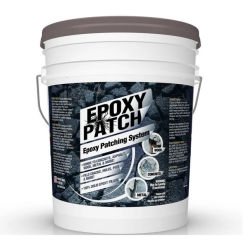
On 2020-08-02 by danny hawks
corner of fireplace hearth broke off. how can i repair?
Question: fireplace "avalanched" into the living room
 The front of my son's fireplace avalanched into his living room. The exterior of the chimney looks great.
The front of my son's fireplace avalanched into his living room. The exterior of the chimney looks great.
We're waiting for engineer's report and how much of this insurance will cover. We suspect they will cover only the portion that has - abruptly- collapsed.
The contractor does not want to repair only the interior and then take responsibility for the entire chimney. He thinks it is safest to replace the entire chimney/fireplace.
Now we're looking for a second contractor to get a second opinion. What an expensive mess. Any advice is appreciated. - Barbara Holub 2020/02/07
Reply:
Barbara:
I'm not sure that the entire chimney needs to be replaced but I can absolutely agree that if I were the contractor called to this job,
- one look at the sloppy masonry exposed in your photo,
- the apparent lack of a lintel across the fireplace opening,
- the apparent absence of proper masonry ties securing the veneer of the fireplace to the block chimney structure,
- the cockeyed blockwork,
- and perhaps other details that can be observed on-site
all point to an amateur chimney mason whose work is at least questionable.
As a contractor I'd not be willing to accept responsibility for work that I did not perform myself and that worse, is mostly not visible.
- What are the country and city of the home, when was it built, and who built this chimney and fireplace?
- Outside are there signs of chimney movement, leaning, cracking, settlement, footing defects?
- In the chimney has the flue been inspected for integrity, damage, sealing, alignment, materials, by a certified chimney sweep?
- Has anyone run a chimscan camera through the flue?
- Is there a basement or crawl space that might give clues to the chimney footing depth?
- Are there photos from time of construction of the chimney?
...
Continue reading at FIREPLACE HEARTH DIMENSIONS & SUPPORT or select a topic from the closely-related articles below, or see the complete ARTICLE INDEX.
Or see FIREPLACE & HEARTH DAMAGE FAQs - questions & answers posted originally at this page
Or see these
Recommended Articles
- CHIMNEY COLLAPSE RISKS, REPAIRS
- CHIMNEY CLEANING PROCEDURE
- CHIMNEY CLEANOUT DOORS
- CHIMNEY FIRE ACTION / PREVENTION
- CHIMNEY FLUE INSPECTION CAMERA
- CHIMNEY DRAFT & PERFORMANCE
- COMBUSTION AIR DEFECTS
- FIREPLACES & HEARTHS - home
- CREOSOTE DEPOSITS, FIRE HAZARD
- FIREPLACE DAMAGE & UNSAFE HEARTHS
- FIREPLACE DAMPER DEFECTS, REPAIRS
- FIREPLACE FLUE SIZE SPECIFICATIONS
- FIREPLACE HEARTH DIMENSIONS & SUPPORT
- FIREPLACE INSERTS INSTALL, INSPECT, REPAIR
- FIREPLACE INSPECTIONS
- FIREPLACE INSPECTION PRE-FAB
- GAS FIREPLACES & GAS LOGS - home
- GAS FIREPLACE VENT CLEARANCE REQUIREMENTS
- GAS FIREPLACE CERAMIC STAINS
- INACCESSIBLE CONNECTIONS FIREPLACE, WOODSTOVE
- RUMFORD FIREPLACE DESIGN RULES
- PYROLYSIS EXPLAINED
Suggested citation for this web page
FIREPLACE DAMAGE & UNSAFE HEARTHS at InspectApedia.com - online encyclopedia of building & environmental inspection, testing, diagnosis, repair, & problem prevention advice.
Or see this
INDEX to RELATED ARTICLES: ARTICLE INDEX to CHIMNEYS & FLUES
Or use the SEARCH BOX found below to Ask a Question or Search InspectApedia
Ask a Question or Search InspectApedia
Try the search box just below, or if you prefer, post a question or comment in the Comments box below and we will respond promptly.
Search the InspectApedia website
Note: appearance of your Comment below may be delayed: if your comment contains an image, photograph, web link, or text that looks to the software as if it might be a web link, your posting will appear after it has been approved by a moderator. Apologies for the delay.
Only one image can be added per comment but you can post as many comments, and therefore images, as you like.
You will not receive a notification when a response to your question has been posted.
Please bookmark this page to make it easy for you to check back for our response.
IF above you see "Comment Form is loading comments..." then COMMENT BOX - countable.ca / bawkbox.com IS NOT WORKING.
In any case you are welcome to send an email directly to us at InspectApedia.com at editor@inspectApedia.com
We'll reply to you directly. Please help us help you by noting, in your email, the URL of the InspectApedia page where you wanted to comment.
Citations & References
In addition to any citations in the article above, a full list is available on request.
- Roger Hankey is principal of Hankey and Brown home inspectors, Eden Prairie, MN, technical review by Roger Hankey, prior chairman, Standards Committee, American Society of Home Inspectors - ASHI. 952 829-0044 - hankeyandbrown.com
- American Gas Association - New Vent Sizing Tables
- Brick Institute of America - Flashing Chimneys
Brick Institute of America - Proper Chimney Crowns
Brick Institute of America - Moisture Resistance of Brick - [8] BOCA Fire Inspector Guidebook, A Correlation of Fire Safety Requirements Contained in the 1987 BOCA National Codes, (newer edition available), Building Officials and Code Administrators International, Inc. (BOCA), Country Club HIlls, IL 60478 312-799-2300 4th ed. Note: this document is reissued every four years. Be sure to obtain the latest edition.
- Chimney Safety Institute of America - Chimney Fires: Causes, Effects, Evaluation
- Costello, Martine, & Josh Kovner, "Rooftop View Turns to Darkness," New Haven Register, 12 May 1992 p. 11: Catherine Murphy was sunning on a building roof when a chimney collapsed; she fell into and was trapped inside the chimney until rescued by emergency workers.
- GAMA - Gas Appliance Manufacturers' Association has prepared venting tables for Category I draft hood equipped central furnaces as well as fan-assisted combustion system central furnaces.
- [9] International Association of Fireplace and Chimney Inspectors, Inc., IAFCI, 5325 N Commerce Ave Ste 5 Moorpark, CA 93021, Website: http://www.membersiafci.org/
- Murphy, Bill & Hansen, Bob, "Top Ten Chimney (and related) Problems Encountered by One Chimney Sweep," Hudson Valley ASHI education seminar, 3 January 2000, contributed by Bob Hansen, ASHI
- [7] National Chimney Sweeps Guild, NCSG, 2155 Commercial Drive, Plainfield, IN 46168, Tel: 317) 837-1500, Website: http://www.ncsg.org/ , Email: mmcsweeney@ncsg.org
- [8] National Fireplace Institute - NFI, Website: http://nficertified.org/ Quoting from the associations website:
The National Fireplace Institute® is the professional certification division of the Hearth, Patio & Barbecue Education Foundation (HPBEF), a 501(c)3 non-profit educational organization for the hearth industry. - National Fuel Gas Code, an American National Standard, 4th ed. 1988 (newer edition is available) Secretariats, American Gas Association (AGA), 1515 Wilson Blvd., Arlington VA22209, and National Fire Protection Association (NFPA), Batterymarch Park, Quincy MA 02269. ANSI Z223.1-1988 - NFPA 54-1988. WARNING: be sure to check clearances and other safety guidelines in the latest edition of these standards
- NFPA 211 - Standards for Chimneys & Fireplaces, NFPA 211: [book at Amazon] Standard for Chimneys, Fireplaces, Vents, and Solid Fuel-Burning Appliances, 2006 Edition (older editions and standards are found at the same bookstore)
- Natural Gas Weekly Update: http://tonto.eia.doe.gov/oog/info/ngw/ngupdate.asp Official Energy Statistics from the U.S. Government
- New York 1984 Uniform Fire Prevention and Building Code, Article 10, Heating, Ventilating, and Air Conditioning Requirements
- New York 1979 Uniform Fire Prevention & Building Code, The "requirement" for 8" of solid masonry OR for use of a flue liner was listed in the One and Two Family Dwelling Code for New York, in 1979, in Chapter 9, Chimneys and Fireplaces, New York 1979 Building and Fire Prevention Code:
- NFPA #211-3.1 - Specific to chimneys, fireplaces, vents and solid fuel burning appliances.
- NFPA # 54-7.1 - Specific to venting of equipment with fan-assisted combustion systems.
- NFPA 211 - 3-1.10 - Relining guide for chimneys
- NFPA 211 - 3-2 - Construction of Masonry Chimneys
- NFPA 211 - 3-3 - Termination Height for chimneys
- NFPA 211 - 3-4 - Clearance from Combustible Material
- NFPA 54 - 7-1 - Venting of Equipment into chimneys
- Reinmiller, Mark J., P.E., "Chimneys and Vents," Mark J. Reinmiller, P.E., ASHI Technical Journal, Vol. 1 No. 2 July 1991 p. 34-38.
- Uniform Mechanical Code - UMC 1991, Sec 913 (a.) Masonry Chimneys, refers to Chapters 23, 29, and 37 of the Building Code.
- US Energy Administration: Electrical Energy Costs http://www.eia.doe.gov/fuelelectric.html
- In addition to citations & references found in this article, see the research citations given at the end of the related articles found at our suggested
CONTINUE READING or RECOMMENDED ARTICLES.
- Carson, Dunlop & Associates Ltd., 120 Carlton Street Suite 407, Toronto ON M5A 4K2. Tel: (416) 964-9415 1-800-268-7070 Email: info@carsondunlop.com. Alan Carson is a past president of ASHI, the American Society of Home Inspectors.
Thanks to Alan Carson and Bob Dunlop, for permission for InspectAPedia to use text excerpts from The HOME REFERENCE BOOK - the Encyclopedia of Homes and to use illustrations from The ILLUSTRATED HOME .
Carson Dunlop Associates provides extensive home inspection education and report writing material. In gratitude we provide links to tsome Carson Dunlop Associates products and services.


